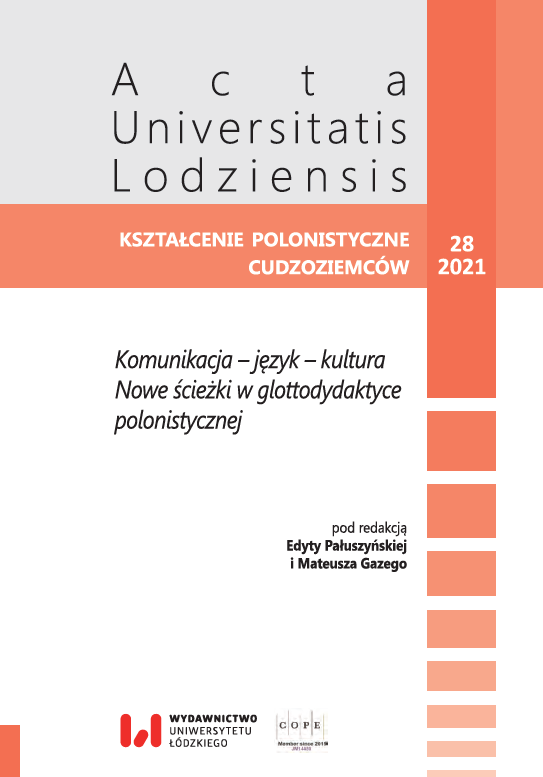Proporcja liczby wyrazów faktycznych i przeciętnych tekstu w kontekście siedmiostopniowej skali trudności jasnopis.pl
DOI:
https://doi.org/10.18778/0860-6587.28.22Słowa kluczowe:
stopień trudności tekstu, zrozumienie tekstu, miara stopnia trudności tekstu, przeciętne słowoAbstrakt
Długość tekstu liczona w wyrazach faktycznych (WF) i przeciętnych (PPW, zob. Moździerz 2020) nie jest identyczna, a stosunek WF do PPW zmienia się w zależności od stopnia trudności wypowiedzi. W badaniach opisanych w niniejszym artykule stosunek ten odniesiono do siedmiopunktowej skali trudności tekstu programu jasnopis.pl (jest to ogólnodostępny algorytm przeznaczony do szacowania stopnia czytelności polszczyzny pisanej). Analiza tekstów autentycznych o łącznej objętości dziesięciu tysięcy WF dla każdego poziomu trudności według w/w skali pozwoliła pokazać, jak stosunek ten zmienia się wraz z rosnącym poziomem trudności tekstu. Opracowany sposób analizy można wykorzystywać w procesie kształcenia językowego, by w sposób szybki i łatwy wstępnie szacować poziom trudności dowolne wypowiedzi pisemnej w języku polskim.
Bibliografia
Alderson J., 2000, Assessing Reading, Cambridge.
Google Scholar
DOI: https://doi.org/10.1017/CBO9780511732935
Broda B., Ogrodniczuk M., Nitoń B., Gruszczyński W., 2014, Measuring Readibility of Brysbaert M., 2019, How many words do we read per minute? A review and meta-analysis of reading rate https://psyarxiv.com/xynwg/ (dostęp: 29.05.2020), DOI: 10.31234/osf.io/xynwg
Google Scholar
DOI: https://doi.org/10.31234/osf.io/xynwg
Carver R.P., 1972, Evidence for the invalidity of the Miller-Coleman Readability Scale, „Journal of Reading Behavior”, nr 4(3), s. 42–47.
Google Scholar
DOI: https://doi.org/10.1080/10862967109546999
Carver R.P., 1976, Word Length, Prose Difficulty and Reading Rate, „Journal of Reading Behavior”, nr 8(2) s. 193–204.
Google Scholar
DOI: https://doi.org/10.1080/10862967609547176
Carver R.P., 1977–78, Toward a Theory of Reading Comprehension and Rauding, „Reading Research Quarterly”, nr 13(1), s. 8–63.
Google Scholar
DOI: https://doi.org/10.2307/747588
Charzyńska E., 2015, Text topic interest, the willingness to read and the level of reading comprehension among adults — the role of gender and education level, „The New Educational Review”, vol. 39, nr 1, s. 84–95.
Google Scholar
DOI: https://doi.org/10.15804/tner.2015.39.1.07
Charzyńska E., Dębowski Ł., 2015, Empirical verification of the Polish formula of text difficulty, „Cognitive Studies”, nr 15, s. 125–132 https://doi.org/10.11649/cs.2015.010 (dostęp: 29.05.2020).
Google Scholar
DOI: https://doi.org/10.11649/cs.2015.010
Chen X., Meurers D., 2018, Word frequency and readability: Predicting the text-level readability with a lexical-level attribute, „Journal Research in Reading”, t. 41, nr 3, s. 486–510. DOI:10.1111/1467-9817.12121
Google Scholar
DOI: https://doi.org/10.1111/1467-9817.12121
Crossley S., Skalicky S., Dascalu M., 2019, Moving beyond classic readability formulas: new methods and new models, „Jorunal of Research in Reading”, t. 42, nr 3–4, s. 541–561. DOI:10.1111/1467-9817.12283
Google Scholar
DOI: https://doi.org/10.1111/1467-9817.12283
Dale E., Tyler R.W., 1934, A Study of the Factors Influencing the Difficulty of Reading Materials for Adults of Limited Reading Ability, „The Library Quarterly: Information, Community, Policy”, nr 4(3), s. 384–412.
Google Scholar
DOI: https://doi.org/10.1086/613490
Dębowski Ł., Nitoń B., Broda B., Charzyńska E., 2015, Jasnopis – A Program to Compute Readibility of Texts in Polish based on Psycholinguistic Research, w: B. Sharp, W. Lubaszewski, R. Delmonte (red.), Natural Language Processing and Cognitive Science, Proceedings 2015, Kraków, s. 51–61.
Google Scholar
DuBay W.H., 2004, The Principles of Readability https://www.researchgate.net/publication/228965813_The_Principles_of_Readability (dostęp: 15.09.2020).
Google Scholar
Ellis N. C., 2002, Frequency Effects in Language Processing: A Review with Implications for Theories of Implicit and Explicit Language Acquisition, „Studies in Second Language Acquisition”, nr 24(2), s. 143–188. https://doi.org/10.1017/S0272263102002024
Google Scholar
DOI: https://doi.org/10.1017/S0272263102002024
Grabe W., 2009, Reading in a Second Language, Cambridge.
Google Scholar
DOI: https://doi.org/10.1093/oxfordhb/9780195384253.013.0006
Gray W., Leary S., 1935, What makes a book readable, Chicago.
Google Scholar
Gruszczyński W. i in., 2015, Measuring Readability of Polish Texts, w: Z. Vetulani, J. Mariani (red.), Materiały Konferencji LTC 2015 (7th Language & Technology Conference: Human Language Technologies as a Challenge for Computer Science and Linguistics, Poznań, 27–29 listopada 2015), Poznań, s. 445–449.
Google Scholar
Lado, R., 1955, Patterns of Difficulty in Vocabulary, „Language Learning”, nr 6(1), s. 23–41 https://doi.org/10.1111/j.1467-1770.1955.tb00829.x
Google Scholar
DOI: https://doi.org/10.1111/j.1467-1770.1955.tb00829.x
Laufer B., 1990, Why Some Words are More Difficult Than Others, „IRAL”, nr 28(4), s. 293–307 https://doi.org/10.1515/iral.1990.28.4.293
Google Scholar
DOI: https://doi.org/10.1515/iral.1990.28.4.293
Na L., Nation, I.S.P. (1985). Factors Affecting Guessing Vocabulary in Context. “RELC Journal”, nr 16(1), s. 33–42 https://doi.org/10.1177/003368828501600103
Google Scholar
DOI: https://doi.org/10.1177/003368828501600103
Piekot T., Zarzeczny G., Moroń E., 2019, Standard „plain language” w polskiej sferze publicznej, w: M. Zaśko-Zielińska, K. Kredens (red.), Lingwistyka kryminalistyczna. Teoria i praktyka, Wrocław, s. 197–214.
Google Scholar
Pisarek, W., 1972. Frekwencja wyrazów w prasie: wiadomości, komentarze, reportaże, „Biblioteka wiedzy o prasie, seria B”, t. 16, Kraków.
Google Scholar
Polish Texts: Baseline Experiments, w: N. Calzolari i in. (red.). Materiały z konferencji LREC 2014 (9th International Conference on Language Resources and Evaluation, Rejkiawik, 26–31 maja 2014), Rejkiavik, s. 573–580.
Google Scholar
Reeves L.M., Hirsch-Pasek K., Golinkoff R., 2005, Słowa i znaczenia – od pojęć pierwotnych do złożonych struktur, w: J. Berko Gleason, N. B. Ratner (red.), Psycholingwistyka, Gdańsk, s. 173–240.
Google Scholar
Seretny A., 2006, Wskaźnik czytelności tekstu jako pomoc w określaniu stopnia jego trudności, „Ling-Varia”, nr 2(2), s. 87–98.
Google Scholar
Seretny A., 2011, Kompetencja leksykalna uczących się języka polskiego jako obcego w świetle badań ilościowych, Kraków.
Google Scholar
Seretny A., 2016, Stopień trudności słowa w perspektywie glottodydaktycznej, „Języki Obce w Szkole”, nr 60(1), s. 18–25.
Google Scholar
Sigurd B., Eeg-Olofsson M., van de Weijer J., 2004, Word Length, Sentence Length and Frequency – Zipf Revisited, „Studia Linguistica”, nr 58(1), s. 37–52.
Google Scholar
DOI: https://doi.org/10.1111/j.0039-3193.2004.00109.x
Sung Y.T. i in., 2015, Leveling L2 Texts Through Readability: Combining Multilevel Linguistic Features with the CEFR, „The Modern Language Journal”, t. 99, nr 2, s. 371–379.
Google Scholar
DOI: https://doi.org/10.1111/modl.12213
Wolter D., 2017, Moving readers from struggling to proficient, „The Phi Delta Kappan”, nr 99, s. 37–39.
Google Scholar
DOI: https://doi.org/10.1177/0031721717728277
Yeni-Koshian G., 2005, Percepcja mowy, w: J. Berko Gleason, N.B. Ratner (red.), Psycholingwistyka, Gdańsk, s. 121–173.
Google Scholar
Pobrania
Opublikowane
Jak cytować
Numer
Dział
Licencja

Utwór dostępny jest na licencji Creative Commons Uznanie autorstwa – Użycie niekomercyjne – Bez utworów zależnych 4.0 Międzynarodowe.










